Introduction
The Heat Flow Meter (HFM) technique is a well-known and accepted method to determine the Thermal ConductivityThermal conductivity (λ with the unit W/(m•K)) describes the transport of energy – in the form of heat – through a body of mass as the result of a temperature gradient (see fig. 1). According to the second law of thermodynamics, heat always flows in the direction of the lower temperature.thermal conductivity of insulating materials like EPS, rock-wool or glass-fiber boards. Also building materials like concrete with higher Thermal ConductivityThermal conductivity (λ with the unit W/(m•K)) describes the transport of energy – in the form of heat – through a body of mass as the result of a temperature gradient (see fig. 1). According to the second law of thermodynamics, heat always flows in the direction of the lower temperature.thermal conductivity and stiff structure can be investigated with the HFM. The Instrumentation Kit extends the measurement range up to 2 W/(m∙K). This application note describes the Instrumentation Kit in detail, and presents data obtained on Pyrex® with the HFM 436/3/1 (figure 1). Its effectiveness is demonstrated by correlating the data with the Laser Flash Analysis (LFA, figure 2) technique.
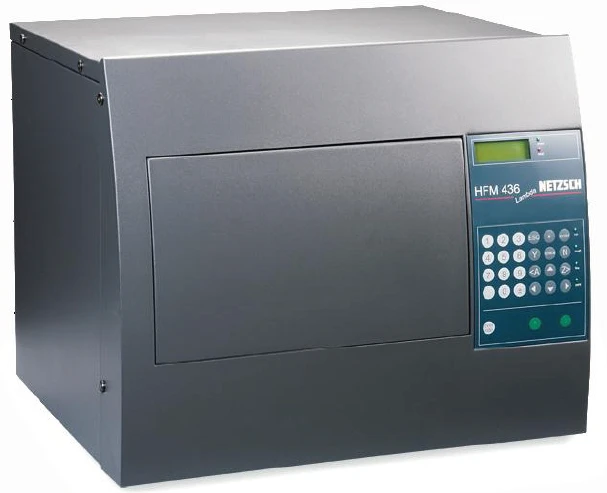
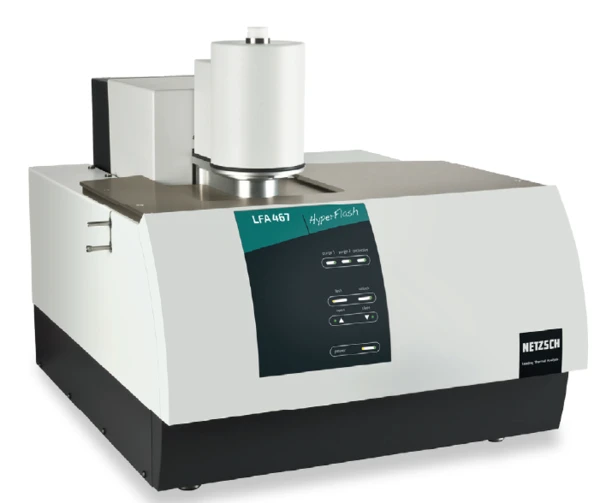
Instrumentation Kit
When testing insulating materials with the HFM technique, the interface thermal resistances between the specimen and the HFM plates are usually negligible, relative to the specimen´s thermal resistance. In case of high conductive and/or stiff samples, this assumption is no longer valid. Even if the specimen´s surfaces are very flat and planeparallel, there always remain some small air gaps at the interface, leading to significant differences between the plates´ and the specimen´s surface temperatures, and an inhomogeneous heat flow through the sample. To avoid these shortcomings, the Instrumentation Kit is necessary. It consists of two external thermocouples, and of two interface layers (figure 3). The interface layers improve the thermal contact between the plates and the specimen, while the external thermocouples are in direct contact to the specimen’s surfaces (figure 4) and therefore measure the exact and “true” surface temperatures (figure 5).
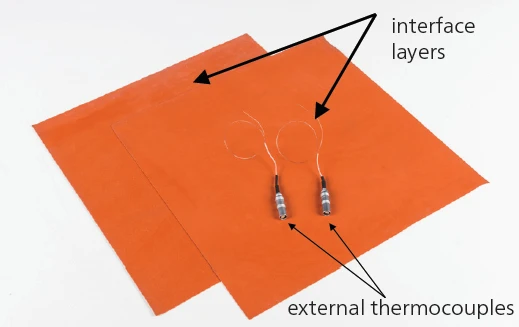
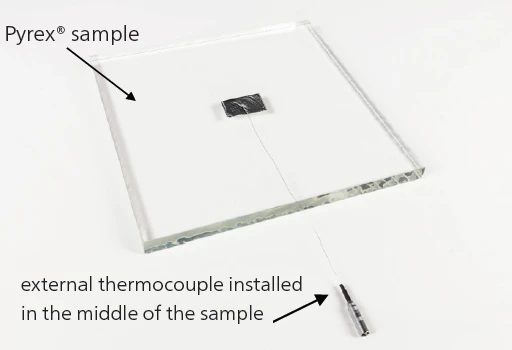

Comparison of Measurement Data on Pyrex® Using the HFM with Instrumentation Kit and LFA Technique
The performance of the Instrumentation Kit is demonstrated with Pyrex®, a homogeneous, chemically stable and wellknown Thermal ConductivityThermal conductivity (λ with the unit W/(m•K)) describes the transport of energy – in the form of heat – through a body of mass as the result of a temperature gradient (see fig. 1). According to the second law of thermodynamics, heat always flows in the direction of the lower temperature.thermal conductivity reference material since the 1960´s with a Thermal ConductivityThermal conductivity (λ with the unit W/(m•K)) describes the transport of energy – in the form of heat – through a body of mass as the result of a temperature gradient (see fig. 1). According to the second law of thermodynamics, heat always flows in the direction of the lower temperature.thermal conductivity of about 1.14 W/(m∙K) at 23°C [1].
The reported data were carried out on specimens measuring 300 mm x 300 mm x 20 mm with and without Instrumentation Kit. The calibration of the heat flux sensors was achieved with a NIST certified glass-fiber board (1450D) without instrumentation kit, in accordance with ASTM C 518. Three different Pyrex samples (A, B, C) from the same batch were tested. Two samples (1, 2) with a diameter of 12.7 mm and a thickness of 2.5 mm were also prepared from the same batch for the LFA tests. The measurements were performed with the LFA467 Hyperflash.
Table 1 shows the results at 23°C from different HFM and LFA tests. The small standard deviation (1.7%) of the HFM tests demonstrates the good reproducibility of the method. The mean Thermal ConductivityThermal conductivity (λ with the unit W/(m•K)) describes the transport of energy – in the form of heat – through a body of mass as the result of a temperature gradient (see fig. 1). According to the second law of thermodynamics, heat always flows in the direction of the lower temperature.thermal conductivity of 1.15 W/(m∙K) shows a deviation of only 0.88% to the mean value from LFA and literature. This proves the accuracy of the HFM measurements with the Instrumentation Kit.
Table 1: Thermal conductivity of Pyrex® at 23°C using HFM and LFA
Method | Sample/Measurement | W/(m∙K) | W/(m∙K) |
|---|---|---|---|
| HFM | Pyrex A | 1.13 | 1.15 |
| Pyrex B | 1.17 | ||
| Pyrex C | 1.14 | ||
| HFM | Pyrex without Instrumentation Kit | 0.53 | 0.53 |
| LFA | Pyrex - 1 | 1.14 | 1.14 |
| Pyrex - 2 | 1.14 |
Without the Instrumentation Kit, the high thermal Contact ResistanceAccording to the second law of thermodynamics, heat transfer between two systems always moves in the direction from higher to lower temperatures. The amount of thermal energy transferred by heat conduction, e.g., through a wall of a building, is influenced by the thermal resistances of the concrete wall and the insulation layer.contact resistance and the unknown surface temperatures lead to a Thermal ConductivityThermal conductivity (λ with the unit W/(m•K)) describes the transport of energy – in the form of heat – through a body of mass as the result of a temperature gradient (see fig. 1). According to the second law of thermodynamics, heat always flows in the direction of the lower temperature.thermal conductivity of 0.53 W/(m∙K), significantly lower than the expected value.
Figure 6 depicts results from 10°C to 65°C with the HFM, the LFA and literature values (error bars ± 5%). Over the whole temperature range, the HFM and LFA results are in good agreement with literature values (max. deviation 2.8% – LFA and 3.9% – HFM).
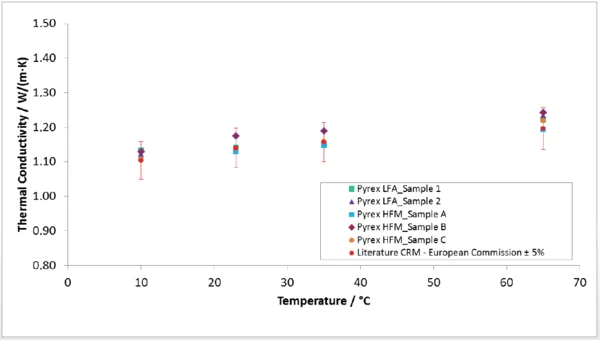
Summary
The Thermal ConductivityThermal conductivity (λ with the unit W/(m•K)) describes the transport of energy – in the form of heat – through a body of mass as the result of a temperature gradient (see fig. 1). According to the second law of thermodynamics, heat always flows in the direction of the lower temperature.thermal conductivity of stiff materials up to 2 W/(m∙K) can be reliably investigated with the HFM, provided that the surface temperatures are accurately measured. This is achieved with the Instrumentation Kit, which ensures a homogeneous heat flow and true specimen´s surface temperatures. The data of the HFM measurements with the Instrumentation Kit are highly reproducible and in good agreement with the results from the LFA technique and literature. Furthermore, the long term stability qualifies Pyrex® as a material of choice for verifying the performance of the HFM with Instrumentation Kit prior to measuring unknown, high conductive samples.